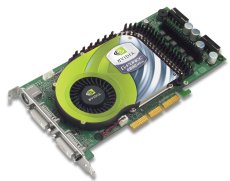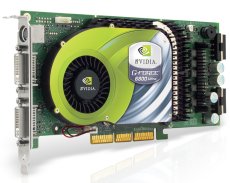Cooling and PowerThe reference boards that were shipped to reviewers differ slightly from the marketing pictures that NVIDIA provided in that the cooling solution is a double height solution where it appears they expected to be going for a single slot solution.
As you can see the reference board's heatsink is quite different from that of the marketing shots, although they both have similarities in their design. Both feature radial fans, designed to push air over the metal in contact with the chip, and out over the back of the board. They both have a heat pipe that spans the memory and it appears that it is designed such that the heat pipe is cooled by the exhaust area of the blower, such that this can be transferred round to the other ram chips by the liquids in the pipe. Another of the most immediately noticeable elements of the board is the fact that it requires two molex connectors to provide the power to it. While we are now familiar with seeing most high end, and some mid end, boards requiring a single internal power supply, only XGI’s Volari V8 Duo has had requirements for two power connectors before, presumably one for each of the two chips it drives – on NV40, though, the power requirements are such that it wouldn’t be safe to let one internal connector provide the power, so the load is split over two. When we initially saw test boards NVIDIA’s David Kirk informed us that NV40’s power requirements was in the order of 120 Watts (although whether this is for the full board or just the chip itself is unclear), so those with a high end system and a CPU such as Prescott may be needing to revaluate their PSU should they be considering a move to NV40 - NVIDIA themselves state that a 480W power supply is required. Two power connectors are required because a single wire is not able to provide the full supply to the board, so you should also consider that two lines directly from the PSU should be used for the NV40 and not a single line split. There is also a beeper on the board, which presumably sounds to warn you when there are any power related issues. At a 120W draw, two power supplies are required because of the low power supply of the AGP bus; when the PCI-Express version of NV40 (NV45?) becomes available you’ll likely find that only one internal power connector is required as PCI-Express can provide 75W of the power directly over the bus. Note that the fan appears to be variable speed dependant on the temperature. When the PC is turned the fan spins up to full speed, where it is quite loud, but once the drivers are loaded it spins down to a level that is barely audible over the P4 CPU fan. We ran an open test system it may be the case that in an enclosed environment the temperature may rise and the fan spin up even faster, thus beginning to be more audible. At present the 2D and 3D operating speeds are the same, however NV40 is capable of altering it clock speeds for various conditions, so it is possible that this may be enabled on final boards. The boards that reviewers have received were slightly delayed and have had manual revisions, which we assume are related. A close look at the back of the board reveals an additional wire and a coil at the area of the fan power supply from the board and we are beginning to suspect there have been some fairly last minute specification changes to the boards. The boards we had previously seen at CeBit, and probably the ones that shipped to developers and been used at GDC, had core speeds of 475MHz, yet the final Ultra specification, we are assured, is 400MHz. Indeed, looking at the driver strings we can see the following references: NVIDIA_NV40.DEV_0040.1 = "NVIDIA GeForce 6800 Ultra" However, checking the chipset device IDs on the system reveals the board to have a device id of "0041", which corresponds to the non-Ultra variant in these particular drivers. We are wondering if there have been some last minute heat and / or related power concerns that has forced a change in specification and larger cooling solutions. All things considered, the size of the cooling hardly matters in most normal modern desktops because of the level of integration in current motherboards, since rarely does anyone use all the PCI slots. A single slot cooling solution is only really required if you want to make the board available to small form factor PCs, and the real question is: how many small form factor PC's ship with 480W power supplies? In this instance, with GeForce 6800 Ultra's power requirements keeping a 2 slot solution is probably a wise decision. However, these are still reference boards and shipping boards may have different cooling solutions |
|
||||||||
NV40 - GeForce 6800 Ultra Review - Page 4
Published on 14th Apr 2004, written by Dave Baumann for Consumer Graphics - Last updated: 20th Jul 2007




